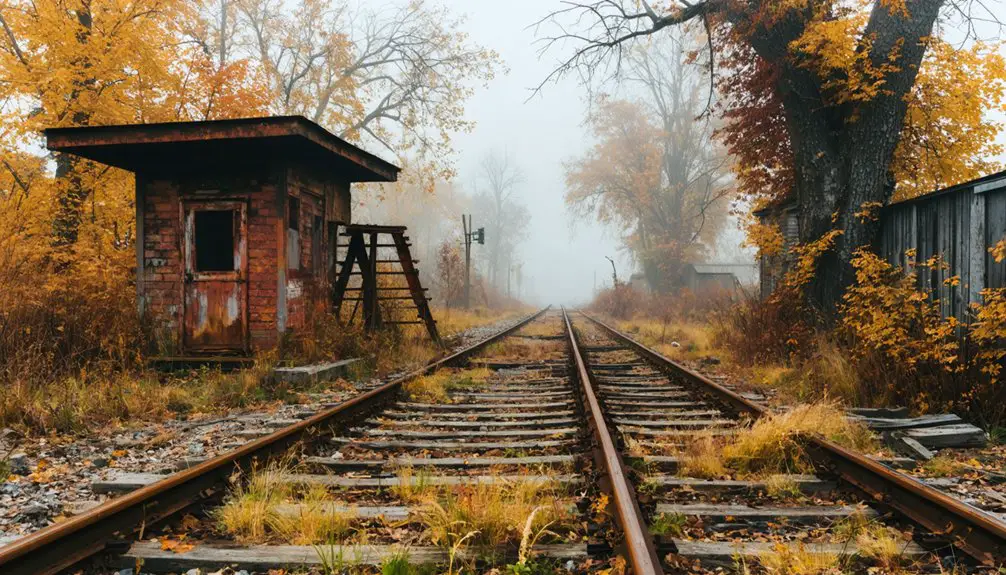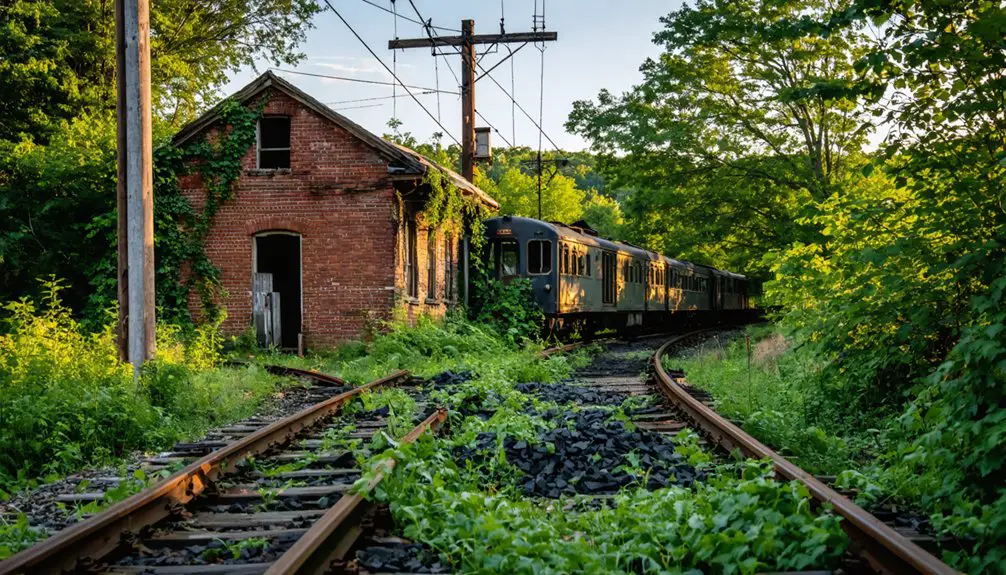You’ll find Blairsville Junction at the historic crossroads of the Northern Turnpike and Conemaugh River, where it flourished as a major railroad hub in the 1800s. The site featured a seven-locomotive roundhouse and extensive rail facilities, employing up to 30% of local workers. After the Penn Central’s 1970 bankruptcy and mine closures, the population dropped from 5,296 to 3,252. Today, the Ghost Town Trail preserves remnants of this once-thriving industrial center’s fascinating past.
Key Takeaways
- Blairsville Junction transformed from a thriving railroad hub to a ghost town following the decline of coal mining and railroad operations.
- The Ghost Town Trail preserves Blairsville’s industrial heritage as a National Recreation Trail, featuring remnants of its railroad infrastructure.
- Population declined from 5,296 in 1930 to 3,252 in 2020, reflecting the area’s economic deterioration after mine closures.
- Archaeological sites and building foundations document the town’s transition from railroad prosperity to post-industrial decline.
- The Penn Central Transportation Company’s 1970 bankruptcy marked a crucial turning point in Blairsville Junction’s decline toward ghost town status.
The Rise of a Railroad Hub
When Blairsville was founded in 1818 at the strategic junction of the Northern Turnpike and Conemaugh River, few could have predicted its transformation into a major railroad hub. The transportation evolution began with the Pennsylvania Main Line Canal, creating a crucial slackwater pool for dock operations. Early foundries and salt works helped establish the town’s industrial base.
From humble river crossing to bustling rail center, Blairsville’s strategic location shaped its destiny as a transportation powerhouse.
You’ll find the true railroad expansion took root in 1851 when the first Pennsylvania Railroad branch in Indiana County arrived, marked by the historic appearance of the Henry Clay locomotive that December. The railroad industry provided 20 to 30 percent of local jobs, becoming vital to the community’s economy.
By 1860, Blairsville had become the headquarters of the Western Pennsylvania Railroad, complete with a seven-locomotive roundhouse, repair shops, and extensive office facilities.
The town’s strategic position enabled connections to Indiana and Saltsburg by 1878, while the westward line to Allegheny City opened in 1871, cementing Blairsville’s prominence in the region’s rail network.
Life in a Coal Mining Community
Beyond the railroad tracks that transformed Blairsville Junction into a transportation powerhouse lay the heart of its working-class identity: the coal mines.
You’d find miners spending long hours underground in room-and-pillar mines, facing daily dangers from cave-ins, gas explosions, and the ever-present threat of black lung disease. Workers earned about two dollars per oven during their shifts, which helped sustain their families despite the hazardous conditions. The room-and-pillar method allowed miners to extract between 35% to 70% of available coal while leaving support columns to prevent collapse.
Strong community bonds formed in the company-owned housing where families lived close together. You could witness these tight-knit relationships at church gatherings, social events, and during labor struggles when workers united to fight for better conditions.
The town’s infrastructure supported mining life, with essential services like shops and schools serving diverse ethnic groups, including a thriving African American community centered around the AME Zion Church.
Despite harsh conditions, residents built resilient communities that shared both the burdens and triumphs of mining life.
Railroad Infrastructure and Operations
At the heart of Blairsville Junction‘s rail network, you’d find an intricate web of narrow and standard-gauge tracks that connected the Pennsylvania Railroad with essential coal transport lines.
You could observe the junction’s control center, where telegraph operators and signalmen coordinated train movements using mechanical semaphores and hand signals to guide the steady flow of coal shipments.
The passenger depot, though secondary to freight operations, served as a central hub where travelers could board trains while watching the constant parade of coal-laden cars moving through the bustling yard.
Junction Rail Network Design
Through meticulous engineering and operational planning, Blairsville Junction’s rail network design served as a critical transportation hub with four distinct route paths connecting its main and branching lines.
You’ll find the junction’s capacity was carefully assessed to handle traffic loads while maintaining efficient flow between destinations. The track alignment considered the region’s unique topography and environmental features, minimizing friction at switch points and crossings. Similar to modern projects like the Cross River Rail, the junction required complex engineering beneath challenging terrain conditions. The strategic spacing between junctions equaled three train lengths to ensure optimal traffic flow.
The junction’s spacing accommodated the era’s longest trains, preventing operational bottlenecks that could’ve disrupted the network’s flow.
Digital reconstruction shows how the infrastructure integrated standard rail types with precise sub-structure layers of ballast and formation materials. This engineering marvel followed right-hand traffic patterns typical of American railways, with strategic placement of switches and crossings to maximize operational flexibility.
Train Operations Control Center
The nerve center of Blairsville Junction’s rail operations resided in its sophisticated Train Operations Control Center, where dispatchers coordinated movements across the network’s four major routes.
Through computerized train monitoring systems and real-time displays, controllers maintained continuous oversight of mainline activities while managing critical infrastructure like switches, signals, and power systems.
You’d find skilled operators making cooperative decisions with field personnel, guided by strict operational protocols to guarantee safety. The modern facility exemplified the industry trend toward centralized operations, improving coordination efficiency across all units.
The center’s authority extended beyond just train movements – they supervised ventilation, drainage, and emergency communications systems. The control room utilized predictive maintenance systems integrated with digital platforms to optimize resource allocation and detect potential equipment faults early.
When incidents occurred, the control center staff coordinated directly with emergency services and implemented immediate safety measures.
Their thorough training in operational rules and area-specific characteristics made them the primary command point for both routine operations and emergency response.
Passenger Loading Facilities
During Blairsville Junction’s peak operations, passenger loading facilities served as essential infrastructure for the Pennsylvania Railroad‘s extensive network.
You’d find carefully designed platforms built from wood or stone, featuring wooden planking that aligned perfectly with train car heights for safe boarding and alighting.
The station’s platform design included covered waiting areas to shield you from harsh weather, while strategic lighting enhanced visibility and security.
You could purchase tickets at the station office, where staff managed travel arrangements and luggage handling for local and long-distance journeys.
The station was a key stop along the Underground Railroad, providing safe passage for freedom seekers traveling through western Pennsylvania.
Passenger amenities included comfortable benches, clear signage, and dedicated loading docks.
Multiple platform levels accommodated different train car configurations, with steps connecting various heights.
The facilities supported connections to Indiana and Saltsburg, cementing Blairsville’s role as a crucial regional rail hub.
The station’s efficient design reflected the railroad’s commitment to maintaining dividend payments uninterrupted for nearly a century until 1946.
Daily Life and Social Fabric

Life in Blairsville Junction centered around coal mining operations, where company-built houses clustered tightly near industrial sites created close-knit communities of immigrant workers and their families.
You’d find daily routines dictated by mine schedules, with workers heading to and from the coal mines while their children attended nearby company schools.
Community gatherings often took place at local churches, the company store, or multi-purpose buildings that served as both schools and theaters.
Cultural preservation remained strong among Eastern European immigrants, evidenced by Russian Orthodox cemeteries and religious services.
Your social world would’ve revolved around company-owned amenities – from the store where you’d buy groceries to the bank where you’d manage your earnings.
Life wasn’t just about work; it was about building lasting connections in a close-knit industrial community.
Economic Decline and Transformation
You’ll find that Blairsville Junction’s downward spiral began in the 1930s when coal mines throughout the Blacklick Creek valley started closing, triggering the collapse of the Pennsylvania Railroad’s local operations.
The shuttering of mines and eventual railbanking of the rail line in 1998 led to massive job losses, pushing residents to abandon company towns like Wehrum and Claghorn in search of work elsewhere.
The region’s economic transformation is evident in how the former railroad corridors have been converted into the Ghost Town Trail, shifting from industrial transportation to recreational tourism between 1991 and 2009.
Railroad Industry Collapse
As the Penn Central Transportation Company plunged into bankruptcy on June 21, 1970, it marked not only the largest corporate failure in U.S. history at that time but also signaled the devastating decline of America’s railroad industry.
You can trace the collapse to a perfect storm of financial mismanagement, incompatible corporate cultures following the 1968 merger, and suffocating railroad regulations from the Interstate Commerce Commission.
The company’s deficit skyrocketed from $2.8 million to a staggering $325.8 million in just two years.
This collapse disrupted one-third of the nation’s passenger service and crippled freight operations throughout the Northeast.
Places like Blairsville Junction felt the impact most severely as the industry’s downfall accelerated regional deindustrialization, transforming countless rail-dependent communities into ghost towns.
Mine Closures Impact Community
The closure of Blairsville Junction’s coal mines dealt a devastating second blow to the already struggling community.
You’d have witnessed the rapid economic decline as mining families lost their primary source of income, forcing many to accept lower-paying jobs or relocate entirely. The exodus of younger workers particularly crippled the town’s liveliness.
Despite economic diversification strategies attempting to attract new industries and community resilience initiatives focused on tourism and heritage preservation, the town couldn’t overcome its challenges.
Local businesses that once thrived on miners’ patronage shuttered their doors, while abandoned mine facilities became hazardous eyesores.
The social fabric unraveled as unemployment led to increased poverty, substance abuse, and depression. Tax revenues plummeted, leaving local government struggling to maintain basic services and manage costly environmental remediation projects.
Population Migration Patterns
Since reaching its peak population of 5,296 residents in 1930, Blairsville Junction has experienced a persistent demographic decline that mirrors its economic transformation.
You’ll find the town’s population has steadily decreased to 3,252 by 2020, with population shifts driven primarily by economic factors rather than cultural changes.
The town’s evolution from a bustling transportation hub to its current state reflects broader regional changes.
When key transportation routes bypassed the area and the downtown’s commercial significance diminished, many residents relocated to more prosperous nearby communities.
While you’ll notice recent attempts at economic diversification through cultural heritage tourism, these efforts haven’t reversed the declining population trend.
The aging demographic profile, with a median age of 49.6 years, suggests this pattern may continue despite modest income growth.
Preservation Efforts and Historical Legacy
While many ghost towns fade into obscurity, Blairsville Junction’s legacy endures through dedicated preservation initiatives and historical documentation efforts.
You’ll find this heritage preserved along the Ghost Town Trail, designated as a National Recreation Trail by the U.S. National Park Service. Through community involvement and educational initiatives, historical markers tell the story of Black Lick Valley’s industrial past.
Despite challenges of private property restrictions and natural decay, researchers continue documenting the site’s history through publications like “Delano’s Domain.”
The Indiana County and Cambria & Indiana Trail Council have transformed old rail corridors into recreational trails, while preserving the mining landscape.
Though physical remains are limited, you can explore the area’s rich history through interpretive exhibits, cemetery sites, and architectural remnants that survive along the trail corridor.
Ghost Town Trail Connection

Modern visitors to Blairsville Junction now experience its history through an extensive rail-trail network spanning 49 miles across Indiana and Cambria counties.
Discover the past while exploring 49 miles of historic rail-trails connecting Indiana and Cambria counties at Blairsville Junction.
You’ll find this ghost town exploration opportunity along the trail system that follows the former Pennsylvania Railroad’s 1904 line, which once served bustling coal mines along Blacklick Creek.
The trail connects you to multiple historic sites through its 32-mile main stem from Blacklick to Ebensburg and 17-mile C&I Extension. You can access the trail’s rich history from various trailheads, including Saylor Park in Blairsville, Heshbon, and Dilltown.
The trail’s crushed limestone surface, built over former railroad ballast, lets you trace the path where trains once hauled coal and timber during the region’s industrial heyday.
Several restored bridges from the 1977 flood highlight the trail’s commitment to preserving local history.
Archaeological Remains and Historic Sites
Beneath the trails and abandoned railway lines of Blairsville Junction lie two significant archaeological treasures – the Johnston Site and Newport Village.
At the Johnston Site, you’ll find remnants of a Late Prehistoric Monongahela village of immense archaeological significance. The site reveals circular houses within multiple stockades, along with artifacts including shell-tempered ceramics and rare plant remains that showcase prehistoric agricultural practices.
Newport Village’s historic preservation efforts have uncovered an early American frontier settlement dating to 1790. You can explore the foundations of a hotel, store, and stone wharf that once served as crucial transportation links.
Modern archaeological techniques, from ground-penetrating radar to photogrammetry, continue revealing new discoveries about both sites’ rich histories, documenting centuries of human activity along the Conemaugh River.
Frequently Asked Questions
Are There Any Surviving Descendants of Blairsville Junction Residents Still Living Nearby?
You won’t find documented descendants through local archives or family histories, since the area’s been largely abandoned. Without clear genealogical records tracking residents’ movements, surviving relatives aren’t conclusively confirmed nearby.
What Dangerous Mining Accidents or Disasters Occurred at Blairsville Junction?
You won’t find documented mining fatalities specific to Blairsville Junction in official records, despite Pennsylvania’s broader history of accidents before modern safety regulations were implemented in coal mining communities.
Were There Any Notable Crimes or Lawless Incidents in Blairsville Junction?
You won’t find documented criminal activities or major lawless incidents here. While the area had basic law enforcement through company-controlled security and local jails, records don’t show any notable crimes.
What Native American Tribes Originally Inhabited the Blairsville Junction Area?
You’ll find that Delaware (Lenni Lenape), Shawnee, and Seneca tribes dominated this area’s Native American culture. Their tribal history included using nearby Kittanning Path for travel and settlements.
Did Any Famous People or Historical Figures Visit Blairsville Junction?
Like an empty guestbook, you won’t find famous visitors at this junction. While Warren Delano, FDR’s uncle, founded nearby Wehrum, the area’s historical significance stems from industry, not celebrity appearances.
References
- https://gibson-thomas.com/projects/blairsville-secondary-ghost-town-trail/
- https://en.wikipedia.org/wiki/Ghost_Town_Trail
- https://indianacountyparks.org/our-trails/ghost-town-trail/ghost-town-trail-history/
- https://www.traillink.com/trail-history/ghost-town-trail/
- https://www.youtube.com/watch?v=Qj5LjacccJ0
- https://www.indianacountypa.gov/indiana-county-communities/blairsville/
- https://archive.triblive.com/news/exhibit-explores-blairsvilles-place-in-railroading-history/
- https://pahistoricpreservation.com/celebrating-the-blairsville-area-underground-railroad/
- https://en.wikipedia.org/wiki/Pennsylvania_Railroad
- https://en.wikipedia.org/wiki/North_Western_Railroad



